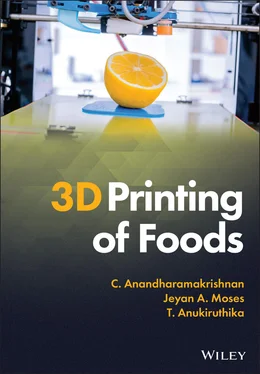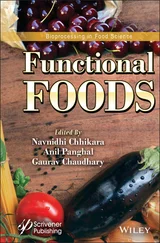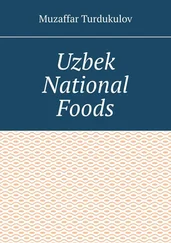C. Anandharamakrishnan - 3D Printing of Foods
Здесь есть возможность читать онлайн «C. Anandharamakrishnan - 3D Printing of Foods» — ознакомительный отрывок электронной книги совершенно бесплатно, а после прочтения отрывка купить полную версию. В некоторых случаях можно слушать аудио, скачать через торрент в формате fb2 и присутствует краткое содержание. Жанр: unrecognised, на английском языке. Описание произведения, (предисловие) а так же отзывы посетителей доступны на портале библиотеки ЛибКат.
- Название:3D Printing of Foods
- Автор:
- Жанр:
- Год:неизвестен
- ISBN:нет данных
- Рейтинг книги:3 / 5. Голосов: 1
-
Избранное:Добавить в избранное
- Отзывы:
-
Ваша оценка:
- 60
- 1
- 2
- 3
- 4
- 5
3D Printing of Foods: краткое содержание, описание и аннотация
Предлагаем к чтению аннотацию, описание, краткое содержание или предисловие (зависит от того, что написал сам автор книги «3D Printing of Foods»). Если вы не нашли необходимую информацию о книге — напишите в комментариях, мы постараемся отыскать её.
Explore the fascinating realm of 3D food printing and its applications 3D Printing of Foods
3D Printing of Foods
3D Printing of Foods
3D Printing of Foods — читать онлайн ознакомительный отрывок
Ниже представлен текст книги, разбитый по страницам. Система сохранения места последней прочитанной страницы, позволяет с удобством читать онлайн бесплатно книгу «3D Printing of Foods», без необходимости каждый раз заново искать на чём Вы остановились. Поставьте закладку, и сможете в любой момент перейти на страницу, на которой закончили чтение.
Интервал:
Закладка:
3 Food Components and Their Role in Printability
CHAPTER MENU
1 3.1 Recipes in ‘Print and Eat Technology’
2 3.2 Role of Food Constituents
3 3.3 Panorama of Food Printing
4 3.4 Insights on the Printability of Different Food Constituents3.4.1 Carbohydrates and Starch 3.4.2 Proteins and Amino Acids 3.4.3 Lipids and Fatty Acids 3.4.4 Dietary Fibre 3.4.5 Other Additives
5 3.5 Classification of Foods Based on Their Printability
6 3.6 Conclusion
3.1 Recipes in ‘Print and Eat Technology’
Food is an essential component of life comprised of various macro and micronutrients. The complex nature of food makes digestion to be pretty complicated. The composition of a diet plays a major role in fulfilling the daily needs and energy requirements. Macronutrients include carbohydrates, proteins, fat, and dietary fibre. On the other hand, vitamins and minerals are grouped as micronutrients. Nowadays the dietary pattern of food is kept on changing with busy and hectic lifestyle (Phan and Stodolska 2019). Formulation of a convenient diet without compromising nutrition is the need of the hour. As a printandeat technique, 3D food printing promises to be a futuristic technology that addresses the nutritional needs and the dietary requirements of the modern world. The science of printing is quite interesting as food printing allows consumers to design their own recipe. Food printing is an iteration of novelty and creativity that mingle the digitalized intricate designing with traditional cuisines (Anukiruthika et al. 2020). The success of a food recipe depends on consumer perception, characteristics of material supply and acceptability of end‐product. Printing of food allows for flexibility and more degrees of freedom to test inexperienced food material supplies like alternative/ uncommon food ingredients (Nachal et al. 2019). Researchers have classified printing recipes as element and traditional recipes. Element‐based recipes were based on a pre‐set of standardized formulation and material dispensing that determines the sensory attributes of food. Experiments were conducted by Massachusetts Institute of Technology (MIT) researchers on element‐based printing recipes using Virtuoso Mixer™, Robotic Chef™, and Digital Fabricator™ printers. On the other hand, traditional recipes aimed at developing a customized food by modifying the existing printing recipes. Examples of this category include the fabrication of customized chocolates and sugar sculptures (Sun et al. 2015). Mainly traditional printing helps in the formulation and design of new recipe based on consumers preference. A combination of element and traditional based recipes would open up for exemplar dishes out of 3D printing.
3.2 Role of Food Constituents
Consumer’s preference towards new recipes is decided by five key factors that include price, convenience, palatability, experience, and nutrition. An American survey on food habits revealed that 47% of consumers considered themselves to be health‐conscious while the other 35% of people described themselves as ingredient sensitive (Sun et al. 2018). Healthy dietary concepts are the trending topics of the day that turned the attention towards personal foods and health care products. A healthy diet consists of a proportional amount of macro and micro food constituents that are essential for the normal metabolism of the body. Each of the food constituents is equally important and has its functionality (Sammugam and Pasupuleti 2019). Most of the energy is obtained from dense food constituents such as carbohydrates and lipids. Carbohydrates form a major group of energy‐giving macronutrients that comprises sugars, starches and cellulose. Cereal grains, starchy vegetables, roots and tubers, and fruits are rich in carbohydrates. Another dense food constituent is lipids that comprise of fatty acids and triglycerides which are present in nuts, oilseeds, dairy products, and flesh foods. Proteins are a group of amino acids that forms a vital part of regular diet obtained from pulses and legumes, red meat, and flesh products. Other than macro elements, fruits, and vegetables also possess an ample quantity of essential vitamins and minerals that are required for revitalizing the body. Any discrepancy in these constituents will lead to an imbalance of nutrients causing a nutritional deficiency. This scenario increases the incidence of physiological disorders like obesity, cardio diseases, and diabetes (Yahia et al. 2019). A properly balanced diet comprises of all the food constituents in an adequate amounts. With changing climatic conditions and environment, the requirement of nutrients varies from person to person which could not be met by regular food pattern and diet. Food printing is a novel approach for addressing the varying dietary patterns and needs, it aids in mass customization and personalization of foods. Apart from nutritional benefits, each of these constituents significantly contributes to food structures and textures that impart palatability and mouthfeel. Thus, 3D food printing remains to be a single solution for multiple constraints.
3.3 Panorama of Food Printing
As a digitally controlled robotic process, food 3D printing dealt with the sustainable approaches in food manufacturing that would transform the traditional food supply chain. It allows for customized designing of foods, development of prototype models for educating the pre‐school children, personalization of diets by imparting new textures, and taste suitable for people of different age groups (Godoi et al. 2019; Perez et al. 2019). Conventional food production involves the development of limited products with internal designs that restricts the cost. While 3D printing of foods helps in the mass production of designed foods that integrates the artistic skills of culinary professionals without a hike in the cost of production. Being a rapid prototyping tool, food printing paves a way for delivering nutrients in fascinating shapes. In contrast to conventional processing techniques, food printing requires a considerable amount of pre‐processing in order to tailor its physicochemical properties thereby making it suitable for layer‐by‐layer fabrication. Studies were reported on the delivery of fruits and vegetables in attractive shapes thus making the kids consume nutritious food (Severini et al. 2018). It aids in changing the consumer’s mindset that transforms their dislikeness towards a product into likeness. Further food printing helps in cutting down the calorie intake with less fat, less sugar, and less salt and leads to the fabrication of customized patterned food in layers (Prakash et al. 2019). Microstructural designing of food is also possible with the development of printing technology as 3D printing could be used for modifying the fill density of a product that gives a distinct mouthfeel. This micro‐scale printing also helps to incorporate food bioactive compounds into the 3D printed products. Further 3D printing helps to deliver texture modified foods for people with swallowing disorders. All these potential advantages of food printing would lead to the development of a convenient food product that holds a huge market value. Post‐processing of printed foods will add upon taste and contributes to structural integrity to retain its shape. Thus, it is essential to understand the role of each constituent in printability and the response of 3D structures when subjecting to post‐processing treatments. The structural chemistry of food constituents towards 3D printing is discussed in the subsequent sections.
3.4 Insights on the Printability of Different Food Constituents
3.4.1 Carbohydrates and Starch
Carbohydrates are chemical organic compounds comprised of simple sugars and polysaccharides (starch and non‐starch). The latter group of carbohydrates takes more time to get digested than simple sugars and are referred to as dietary carbohydrates. The concept of well‐being and healthy food provokes the fascination towards fibre‐rich diet possessing a low glycaemic response (Amicucci et al. 2019). The digestible polysaccharide, starch comprises of linear amylose and non‐linear amylopectin fractions. These are homopolymers made of glucosidic bonds forming the backbone of starch molecules. Non‐starch polysaccharides are grouped as cellulosic and non‐cellulosic (pectin and hemicellulose) that forms the major part of the plant cells. The polymeric network of polysaccharides and their physicochemical characteristics makes them more suitable for food printing. Most of the 3D printing works reported in the literature were carried out with starch‐based food materials in assessing its behaviour towards printability. On comparing with the other food constituents, carbohydrate‐based printing material supplies possess more tendency of gelation that tailors the consistency and material flowability and hence the layered deposition of 3D constructs ( Figure 3.1).
Читать дальшеИнтервал:
Закладка:
Похожие книги на «3D Printing of Foods»
Представляем Вашему вниманию похожие книги на «3D Printing of Foods» списком для выбора. Мы отобрали схожую по названию и смыслу литературу в надежде предоставить читателям больше вариантов отыскать новые, интересные, ещё непрочитанные произведения.
Обсуждение, отзывы о книге «3D Printing of Foods» и просто собственные мнения читателей. Оставьте ваши комментарии, напишите, что Вы думаете о произведении, его смысле или главных героях. Укажите что конкретно понравилось, а что нет, и почему Вы так считаете.










